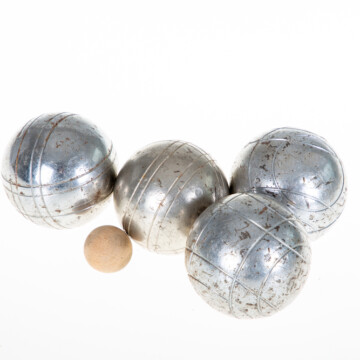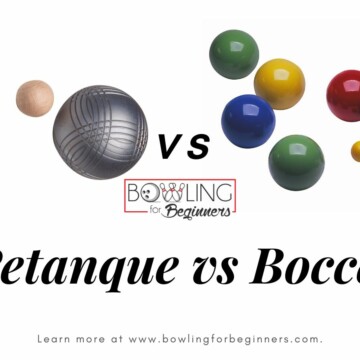
Petanque is an outdoor game that most people have never heard of. Whether you're interested in trying out a new pastime or looking to delve into a unique sporting culture, this article is for you. In it, we will walk you through everything you need to know to start your petanque journey. Let's get right into it!
Contents
- 1 A Brief History of Petanque
- 2 The Basics of Petanque
- 3 Petanque Equipment
- 4 Scoring in Petanque
- 5 How to Play Petanque
- 6 How to Get Good at Playing Petanque
- 7 Petanque Etiquette: Respecting Players and the Game
- 8 Is Pétanque the Same as Bocce?
- 9 What is Pétanque Called in English?
- 10 What is Bowls vs Bocce vs Pétanque?
- 11 Are Pétanque and Boules the same?
A Brief History of Petanque
Petanque's history began in La Ciotat, a French fishing village, in the early 1900s. Two friends began playing on gravel pathways near their homes and soon enough, the game spread throughout France.
Nowadays, it is played across Europe, Asia, South America - pretty much everywhere! It has been adopted by different countries, and regulations differ from place to place. The French version is known as 'pétanque', while in Spain, it’s called ‘boules.’
The Fédération Internationale de Pétanque et Jeu Provençal (FIPJP) is the governing body of petanque.
The Basics of Petanque
The objective of petanque is to throw boules closer to the target boule (called a "cochonnet" or “jack") than your opponent(s). Each team consists of one to three pétanque players and the game can take place on either a circle or square court. The size of the court depends on the number of players; it should be bigger for games with more players.
The game starts by throwing the ‘cochonnet’ followed by a ball from one of the teams. After that, each team takes turns throwing their balls until every player has used all their balls. There are a few more rules you need to know about, and we'll get into them in a section to come.
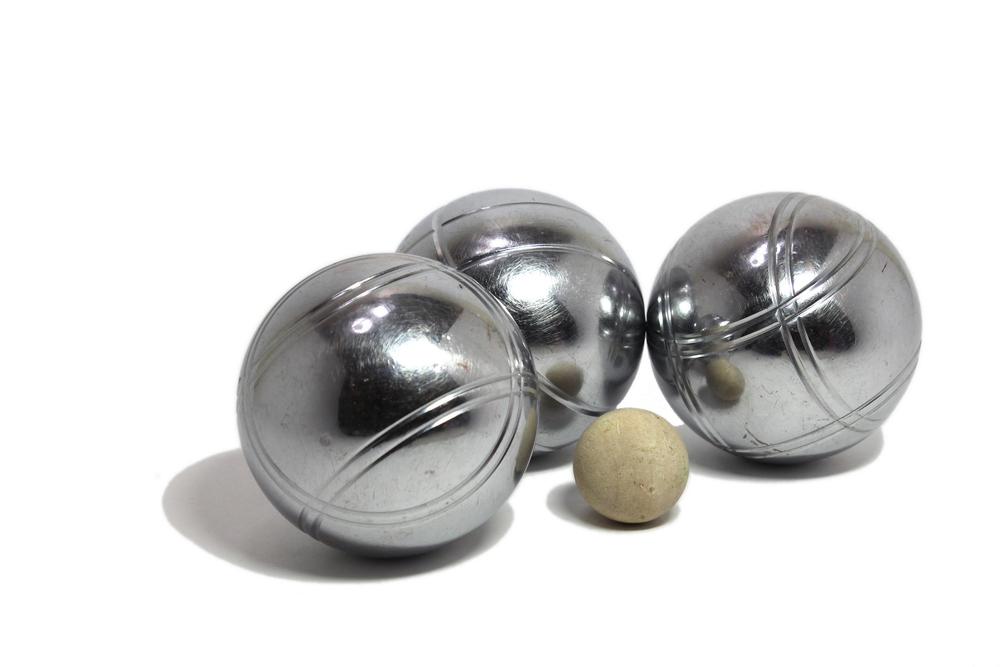
Petanque Equipment
You can't play proper petanque without the right equipment. The most essential piece of equipment is boules, which are the balls used to play the game. They come in different sizes and weights, which can affect the way they move.
The ‘cochonnet’ is a small wooden ball that serves as the target. The other balls are larger and made of metal - each team will have 6 of these. You will also need a measure used to determine which team’s ball is closest to the jack at the end of each round.

Scoring in Petanque
Scoring in petanque is relatively easy to digest. At the end of each round, when all the boules are played, players count up their points by comparing their balls to the jack. A point is awarded for each ball that is closer to the jack than the closest ball of the opposing team.
If a team has two or more balls that are closer, they receive two points. The first team to reach 13 points wins the game. In some games, particularly those in some leagues, the winning point value will be 11 instead of 13.
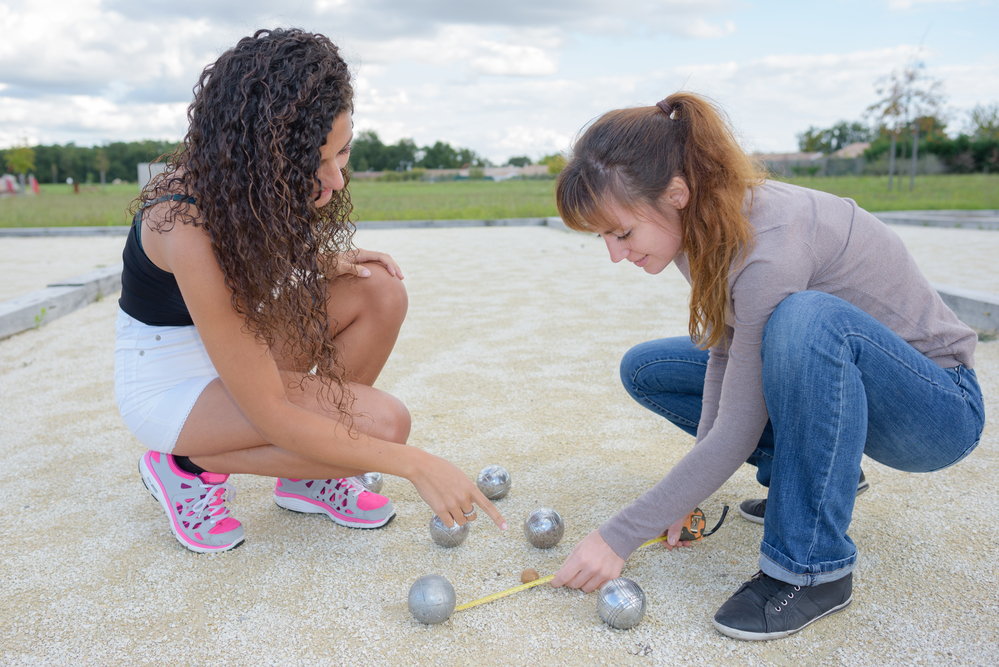
How to Play Petanque
Before you play Petanque, it's important to get a good rundown on how to actually play. We went into the rock bottom basics in the previous section, but it's time to dive a little deeper. Here are some valuable tips to consider when you are playing pétanque either as a beginner or an intermediate player looking to refine their skills:
How to Play:
- Start the Game: Flip a coin to see which team goes first. A player from the starting team throws the cochonnet in addition to one of their metallic balls, trying to get it as close to the cochonnet as possible.
- Opponent's Turn: The opposing team then throws their balls, attempting to get closer to the target boule or even knock away the other team's balls.
- Continue Playing: Teams alternate throws, and the team that doesn't have the closest ball to the cochonnet continues to throw until they either get closer or run out of balls.
- Finish the Round: Once all the balls are thrown, the round is over.
- Scoring: The team with the ball closest to the cochonnet scores one point for each ball that is closer to the cochonnet than the opponent's closest ball.
- Next Round: The winning team of the previous round draws a circle around the jack, signifying the target for the next end.
- Winning the Game: The game continues until a team reaches 13 points, or another agreed-upon score.
Quick Tips:
- Players must keep both feet inside the circle when throwing.
- Different throwing techniques, such as rolling, lobbing, or bouncing, can be used.
- Strategy plays a big part, so consider not only getting close to the cochonnet but also the positioning of the opponent's balls.
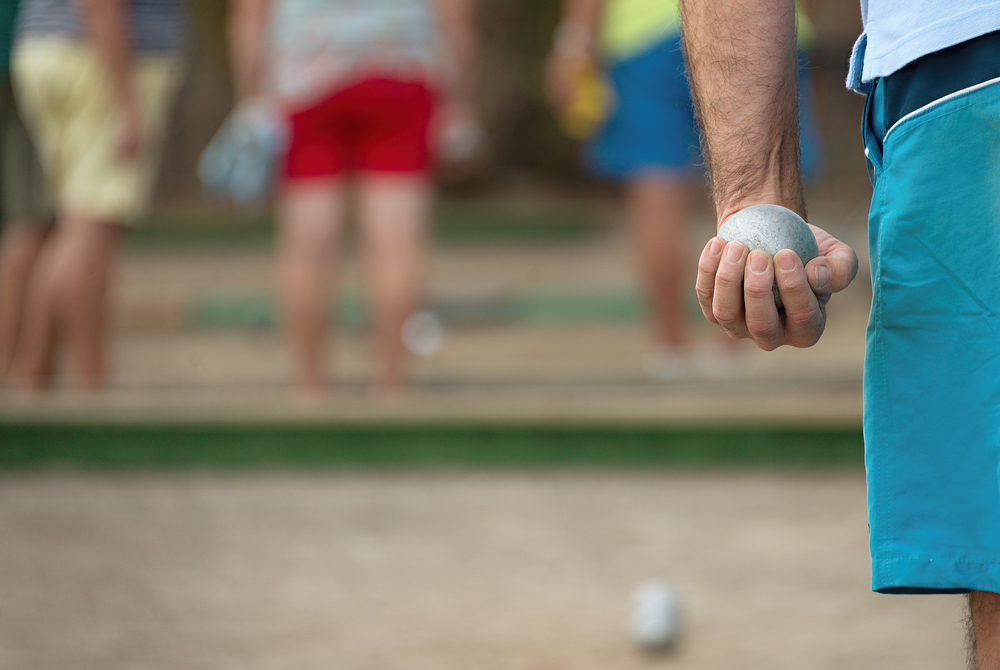
How to Get Good at Playing Petanque
It's important to have a good handle on the basics of playing petanque. But that's not all you need to score predictably and repeatedly during a game. Here are a few tips any new petanque player can use to get good at the game.
- Understand the Ground: The surface you're playing on will drastically affect the movement of your boules. Spend some time observing the ground. Is it hard or soft? Is it flat or does it have a slope? Noticing these details can help you adjust your throwing power and aim appropriately.
- Hold the Boule Correctly: Grip the boule comfortably in your hand, with your fingers spread evenly around its circumference. Some players find it helpful to imagine they're shaking hands with the boule for a solid but not overly tight grip.
- Use Your Wrist: When it comes to throwing boules, using your wrist in addition to your arm can give you better control over the distance and direction.
- Experiment with Techniques: In petanque, there are different throwing techniques — pointing and shooting. Pointing is rolling the boule along the ground, while shooting involves tossing the boule in the air to knock an opponent's boule away from the jack. Try both and see what suits your style and when it works best during your games.
- Practice, Practice, Practice: As with any game, practice is key to improving in Petanque. The more you play, the better you'll understand how to control the boule and use the ground to your advantage. Some things can only be mastered through experience.
- Learn from Others: Watch other experienced players or join a local Petanque club. Observing other players can provide valuable insights and strategies that you can incorporate into your own game.
- Stay Calm and Concentrated: Petanque requires a lot of focus and precision. Stay calm, concentrate on your aim, and try not to rush your throws.
Petanque Etiquette: Respecting Players and the Game
Getting a handle on the rules of petanque is paramount. But if you display bad etiquette during a game, others probably won't want to play with you. Here are some tips every beginner needs to know about petanque etiquette.
- Respect the other players: Healthy competition is a given in petanque, but spats and physical confrontations are not. Be sure to treat others with respect and courtesy on and off the court.
- Be mindful of time: Petanque games can take some time, so try to be patient when others are throwing their boules. At the same time, try not to take an unreasonable amount of time to deliver your boules.
- Keep the court clean and free of debris: This will help ensure that your petanque court is in optimal condition for gameplay.
- Avoid distractions while playing: Be sure to keep conversations focused on the game at hand and put away all phones or other items that may cause distractions.
- Take turns: Alternate shots between players to give everyone a fair chance at success.
- Don't walk across a game in progress: Doing so could distract the players and affect their playing experience. If you need to cross a court, wait until the player has thrown their ball before doing so.
- Be mindful of your noise level: Excessive shouting and cheering can be distracting for other players, so keep noise at a respectful level.
- Be aware of your behavior when playing petanque in public spaces: Stay courteous and respectful of your surroundings, being mindful not to cause disruption or offense.
Is Pétanque the Same as Bocce?
Pétanque and bocce are both popular outdoor games known for their simple yet addictive nature. Despite their similarities, they have distinct characteristics that set them apart. Let's delve into their origins, rules, gameplay and popularity to better understand these two fascinating games.
Origins of Pétanque and Bocce
Pétanque originated in France in the early 20th century, specifically in Provence. The game's name stems from the phrase "pieds tanqués," which translates to "feet planted," reflecting the stationary throwing position of players.
Bocce, on the other hand, has roots in ancient times, tracing back to Egypt. It evolved from a very simplified game of rolling balls toward a target.
Rules and Gameplay
In pétanque, players toss hollow metal balls, aiming to land them as close as possible to a small wooden ball, often referred to as the 'cochonnet'. Players must throw the boule while standing within a circle with both feet on the ground.
Bocce involves rolling larger, solid balls towards a smaller target ball, known as the 'pallino.' Unlike pétanque, bocce players often take a few steps before throwing the ball, similar to the typical bowling delivery.
Court Dimensions and Ball Specifications
A regulation-sized pétanque court measures 15 meters long and 4 meters wide. The balls used in pétanque have a diameter ranging from 71 to 78 mm.
On the other hand, a standard bocce court is significantly larger, measuring 27.5 meters long and 4 meters wide. Bocce balls are also larger than pétanque boules, averaging around 107 mm in diameter.
Popularity and Regional Influence
Pétanque is immensely popular in France and has gained traction in other parts of Europe and Southeast Asia. It's often played casually in city parks and officially in world championships.
Bocce, on the other hand, enjoys widespread popularity in Italy, particularly in the northern regions. It's also well-loved in the United States, Australia, and other parts of Europe.
What is Pétanque Called in English?
In English-speaking regions, the game of pétanque is commonly referred to as "French boules" or simply "boules." Still, the term "pétanque" itself, despite being of French origin, has gained significant recognition and acceptance in various English-speaking nations. This is a testament to the game's growing popularity far beyond its birthplace in Provence, France.
As the sport continues to spread globally, it attracts enthusiasts who appreciate its blend of strategy, skill, and social interaction. Whether it's called pétanque, French boules, or just boules, the essence of this engaging game remains the same across languages and cultures, making it a universally loved pastime.
What is Bowls vs Bocce vs Pétanque?
All three games - bowls, bocce, and pétanque - are outdoor games involving balls and a smaller target. However, they differ in very important ways. Let's examine all three games in the paragraphs below:
Gameplay
Bowls is a game where players roll biased (uneven) balls towards a smaller ball called the 'jack.' The objective is to either get as close as possible to the jack or displace the opponent's balls.
In bocce, players throw larger solid balls towards a smaller one known as the 'pallino.' The goal is to get your balls closest to the pallino.
Pétanque is similar to bocce, where players throw hollow metal balls, aiming to land them as close as possible to a small wooden ball called the 'cochonnet.' Players must throw the boule while standing within a circle with both feet on the ground.
Play Surface and Equipment
Bowls are played on a square grass area divided into playing areas called rinks, with balls that are larger and heavier compared to those used in bocce and pétanque. Bocce, on the other hand, is played on a larger bocce court measuring 27.5 meters long and 4 meters wide.
Bocce balls are larger than pétanque competition boules and leisure boules. Pétanque, played on a regulation-sized court measuring 15 meters long and 4 meters wide, uses balls with a diameter ranging from 71 to 78 mm.
All of the sports have official rules for tournaments and competitions but can be tailored as you please for at-home or casual play.
Scoring Systems
The scoring systems for bowls, bocce, and pétanque also share similarities but have unique nuances.
Bowls
In bowls, points (or 'shots') are awarded to the player or team whose balls are closer to the jack at the end of each end or round.
Bocce
In contrast, bocce employs a more complex scoring system where players will earn a point according to the below rules:
- Points are awarded to the player/team whose balls are closest to the pallino.
- Only one player or team can score in a single frame.
- The scoring team receives one point for each of its balls that are closer to the pallino than the opponent's closest ball. For example, if Team A has two balls closer to the pallino than Team B's closest ball, Team A would score two points.
- If two balls from opposing teams are equidistant from the pallino, and they are the closest balls, then no points are awarded for those specific balls. As you might imagine, this could be a disappointment for the teams.
Petanque
Pétanque, however, takes a simpler approach to scoring. Each end continues until all players have thrown their boules. After the last thrown boule, the round or "end" is over, and it's time to score. Only one team can score points in a single end.
The team with the boule closest to the cochonnet scores a point for that boule and an additional point for each of its other boules that are closer to the cochonnet than the opponent's closest boule.
For instance, if one team has three boules closer to the cochonnet than the opposing team's boules, they score three points for that end.

Are Pétanque and Boules the same?
While the terms "pétanque" and "boules" are often used interchangeably, they are not exactly the same. Here's the meaning of each of the words.
"Boules" is a generic term that refers to a family of games in which the objective is to throw or roll heavy balls as close as possible to a small target ball. There are several types of boules games, including pétanque, bocce, bowls, boule lyonnaise, and raffa, each with its own specific rules and variations.
"Pétanque," on the other hand, refers to a specific type of boules game, the subject of this article. So, while all games of pétanque can be considered boules games, not all boules games are pétanque.
Related Articles
So, there you have it - a rundown on petanque for beginners and casual players alike. As you may have gathered from this article, it's an easy game to learn and can provide hours of fun. All you need is some boules, a cochonnet, a measure, and open space. We hope you found this guide helpful and that you are now ready to get out there and play pétanque!
Kira Byrd, a Certified Fraud Examiner, holds a B.S. in Accounting from the University of Alabama at Birmingham. With a passion for bowling from her childhood, Kira has poured her expertise and personal experiences into creating and nurturing Bowling For Beginners. Kira's mission is to meet new bowlers where they are and guide them toward consistently achieving higher scores. With a focus on skill development and strategic techniques, she empowers readers to take control of their game and unlock their true potential.
Bowling For Beginners embodies strict editorial integrity, ensuring reliable and unbiased information. Kira's commitment to delivering valuable insights and practical strategies is reflected in every article. Here's an explanation of our editorial policy and how we get money.


